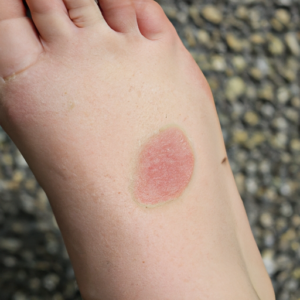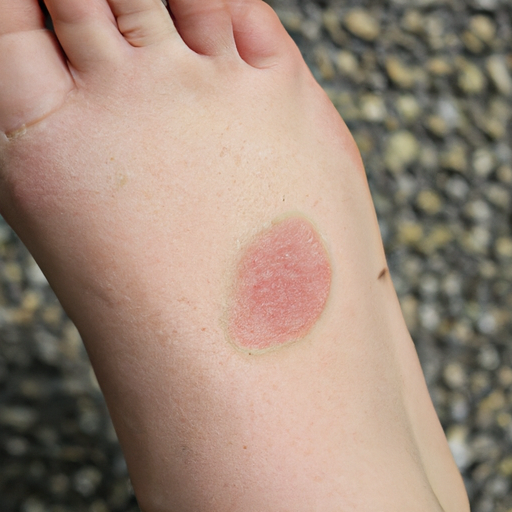Hang On: Let’s Talk About Tineas
Hey there, folks! Today, we’re going to dive into the world of tineas: a group of fungal infections that can affect different parts of the body. You might have heard of ringworm, athlete’s foot, or jock itch – yep, those are all types of tineas! Don’t worry, by the end of this article, you’ll have a better idea of what causes tineas, how to identify them, and most importantly, how to treat and prevent them.
Types of Tineas
Alright, folks, let’s talk about the different types of tineas. First on the list is good old ringworm. Despite its name, it’s not caused by a worm, but rather a fungal infection that looks like a ring-shaped rash. Next up is athlete’s foot, which is a fungal infection that affects the feet and can cause itching, burning, and cracking of the skin. Jock itch is another type of tinea that affects the groin area, causing itching, redness, and flaking skin. Lastly, there’s scalp ringworm, which affects the scalp and can cause hair loss, scaly patches, and crusty sores. It’s important to note that while these tineas are all caused by fungi, they each have unique symptoms and require different treatments. Ringworm can be treated with over-the-counter antifungal creams, while athlete’s foot and jock itch may require medication in some cases. As for scalp ringworm, seeing a doctor may be necessary for a prescription. If you’re experiencing any of these symptoms, don’t hesitate to seek medical attention! It’s better to take care of it sooner rather than later.Get to know the itchy symptoms of Tineas
Tineas are not only contagious but also extremely uncomfortable. They can be identified by the following symptoms:
Itching: The most common symptom of Tineas is itching. It can be mild to severe and can often lead to scratching, which only exacerbates the problem.
Redness: The affected area may become red due to inflammation caused by the fungus.
Flaking skin: Tineas can cause the skin to get dry and flaky. This can be present on the scalp, feet or groin area.

These symptoms can be distressing and can have a significant impact on our daily lives. It is important to seek medical attention as soon as possible if you suspect you have a case of Tineas.
Options to treat Tineas
So, you’ve been diagnosed with tineas. Don’t worry, it’s not the end of the world. There are various treatment options depending on the severity of your infection. Here are a few options:
Antifungal Cream
One of the most common treatment options for tineas is antifungal cream. This cream is applied directly to the affected area and is usually used for minor infections. You can purchase over-the-counter antifungal cream or get a prescription strength cream from your doctor. Be sure to apply the cream according to the instructions on the package to ensure maximum effectiveness.
Oral Medication
If your tinea infection is more severe, your doctor may prescribe oral medication. This medication is taken orally and is used to treat more serious infections, such as scalp ringworm. It’s important to follow the dosage instructions closely and complete the full course of medication. This will help to ensure that the infection is fully eradicated.
Home Remedies
Some people prefer to use natural remedies to treat tineas. These include tea tree oil, garlic, and apple cider vinegar. While these remedies are generally safe, they may not be as effective as traditional treatments. It’s important to speak to your doctor before using any home remedies to ensure they are safe and appropriate for your particular infection.
Remember, it’s important to seek treatment for tineas as soon as possible to prevent the infection from spreading. Additionally, make sure to take preventive measures to minimize the risk of recurrence. These measures include keeping your skin dry and wearing breathable clothing.
Prevention Tips for Avoiding Tineas
As someone who has dealt with tineas before, it’s important to take preventative measures to avoid getting it again. Here are some tips that have worked for me:
Keep Skin Dry
Tineas thrive in moist environments, so it’s important to keep your skin dry. Make sure to thoroughly dry yourself off after bathing or swimming. Use a towel to pat your skin dry instead of rubbing vigorously. Pay extra attention to skin folds and areas that trap moisture, such as between toes and underarms.
Wear Breathable Clothing
Wearing tight, synthetic clothing can trap moisture and heat, which can create the perfect environment for tineas to grow. Opt for breathable fabrics such as cotton or moisture-wicking materials. Loose clothing can also help air circulate around your body and prevent moisture buildup.
Wash and Change Clothes Regularly
It’s important to wash clothes and towels regularly, especially after exercising or sweating. Avoid sharing towels or clothing with others to prevent the spread of tineas. Make sure to also wash your bed linens frequently and vacuum your carpet to prevent the buildup of tinea spores.
Avoid Walking Barefoot
Tineas can easily spread from person-to-person through contact with contaminated surfaces, such as gym floors or locker rooms. It’s important to avoid walking barefoot in public areas and wear protective footwear, such as flip-flops or shower shoes, in communal spaces.
Don’t Share Personal Items
Sharing personal items, such as combs, brushes, or hats, can spread tineas from person-to-person. It’s important to avoid sharing personal items and opt for disposable items or sanitize your belongings to prevent the spread of tineas.
Remember, prevention is key when it comes to avoiding tineas. By taking these simple steps, you can reduce your risk of developing this irritating and uncomfortable fungal infection.
Wrapping It Up: My Final Thoughts on Tinea
So there you have it! Tinea, commonly known as ringworm, athlete’s foot, jock itch or scalp ringworm, is a fungal infection that can affect anyone. The symptoms can be pretty unpleasant, but the good news is that there are many treatment options available.
Antifungal cream and oral medication are popular choices for those looking to rid themselves of tinea. However, for those who prefer natural remedies, there are many options available, including tea tree oil and apple cider vinegar.
The bottom line is that prevention is always better than cure. Keeping your skin dry, wearing breathable clothing, and washing and changing your clothes regularly are key preventative measures to keep in mind. With the right approach, it’s perfectly possible to keep tinea at bay!
Thanks for reading my blog on tinea. I hope you found it helpful and informative. Remember: if you’re struggling with tinea and need professional advice, it’s always worth visiting your doctor or dermatologist. Good luck!
Tinea Treatment FAQ
Can tinea be cured permanently?
Can tinea be cured permanently? Well, as an AI language model, I cannot say for sure. However, tinea, or ringworm, is a fungal skin infection that can be treated with antifungal medication. There are different types of tinea, including tinea pedis (athlete’s foot), tinea corporis (ringworm), and tinea cruris (jock itch). The treatment for tinea depends on the type and severity of the infection. For mild cases, over-the-counter antifungal creams or powders may be sufficient. However, for more severe or persistent cases, prescription antifungal medications may be necessary. It’s also important to practice good hygiene to prevent the spread and recurrence of tinea. Keeping the affected area clean and dry, wearing breathable fabrics, and avoiding sharing personal items (such as towels, combs, and clothing) can all help to prevent the spread of tinea. Furthermore, it’s important to finish the full course of antifungal medication, even if the symptoms have disappeared, to ensure that the infection does not return.In summary, while tinea may not necessarily be curable permanently, it can be effectively treated and prevented with the right medication and good hygiene practices. If you suspect that you have tinea or have any concerns about the best way to treat or prevent it, be sure to consult with a healthcare professional.
How long does it take for tinea to go away?
So, you’re dealing with tinea and want to know how long it takes for this pesky skin infection to disappear, eh? Well, let me tell you, it can vary based on what type of tinea you have, where it is located on your body, and what treatment options you are using. But generally speaking, tinea can last anywhere from a few weeks to a few months, depending on the severity of the infection and your body’s ability to fight it off. Now, in terms of treatment, there are a variety of options available depending on the type of tinea you have. For example, if it’s a case of athlete’s foot, over-the-counter antifungal creams or sprays may be effective. But for more severe cases, a doctor may prescribe stronger antifungal medication in the form of pills or topical ointments. And if it’s a case of scalp tinea (aka ringworm), medicated shampoos are often the go-to treatment. But here’s the thing – even if the tinea appears to have gone away, it’s important to continue treatment for at least a week beyond when the symptoms have disappeared. This is to ensure that the fungus is truly gone and doesn’t come back with a vengeance. So, in short, the answer to how long it takes for tinea to go away is a bit of a tough one to pinpoint – but with proper treatment and patience, it can be a distant memory in no time.
Can tinea resolve without treatment?
Well, let me tell you, as an AI language model, tinea, which is a fungal infection, can actually go away on its own, but treating it is always the best option. There are different types of tinea such as tinea pedis (athlete’s foot), tinea cruris (jock itch), and tinea capitis (scalp ringworm). Treating tinea involves using antifungal medications such as topical creams, ointments, or oral pills depending on the severity and location of the infection. It is important to keep the affected area clean and dry, and avoid sharing personal items such as towels, shoes, or clothing. Moreover, maintaining good hygiene practices and taking preventative measures can help prevent tinea from occurring in the first place. So, my advice is to see a healthcare provider if you suspect you may have tinea, and follow their instructions for treatment. Don’t wait for it to go away on its own, as it may worsen and spread to other areas of the body. Stay healthy and stay fungus-free!
